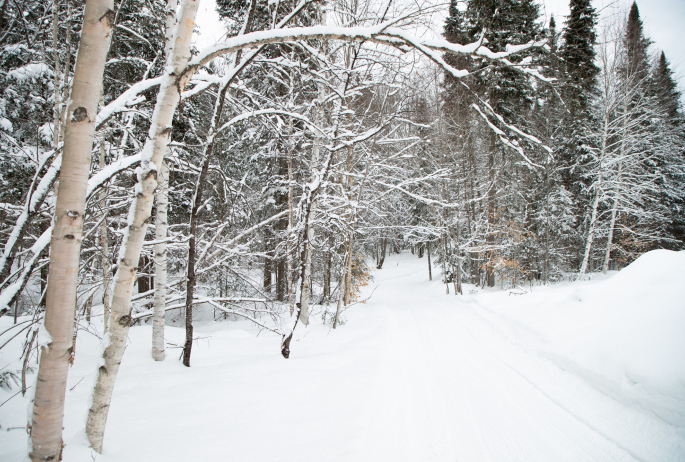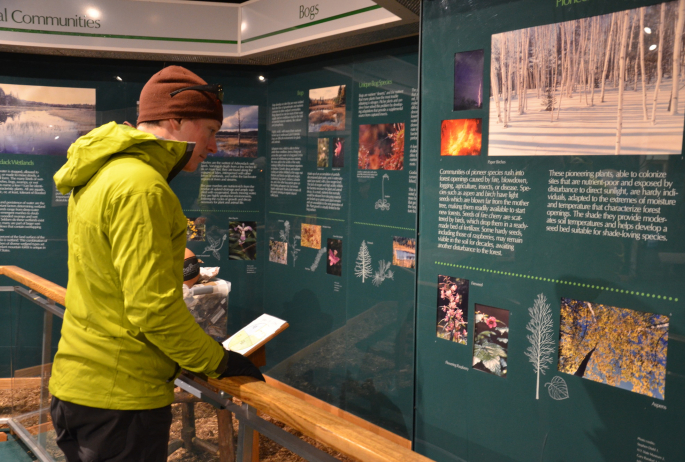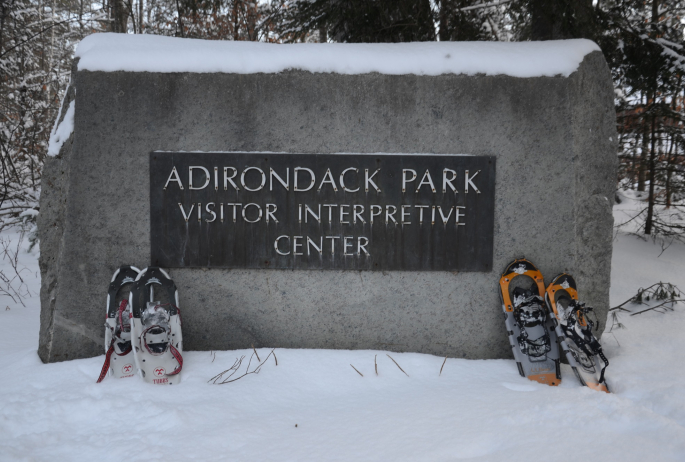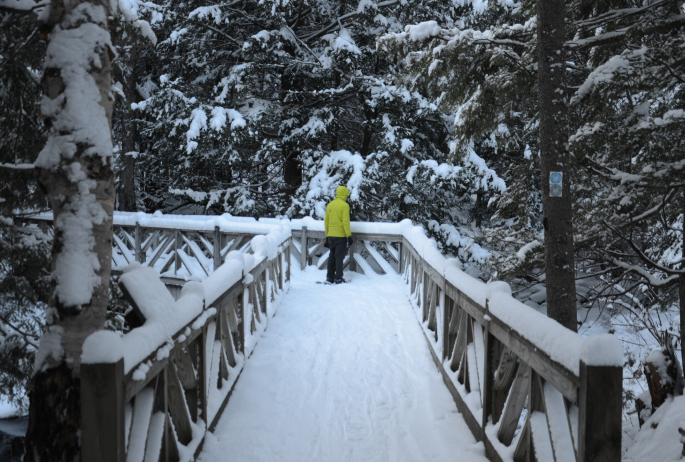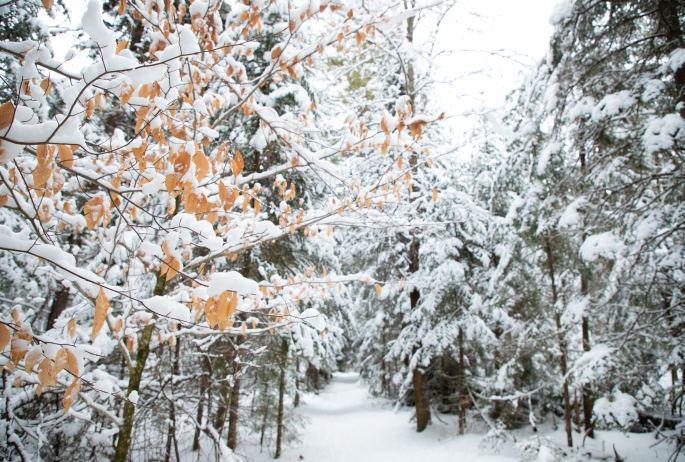In the microclimate of Paul Smith's College Visitor Interpretive Center (VIC), I find myself in a winter wonderland, as if a Hollywood special effects crew came through and sprayed and hosed down the vast landscape with deep, sticky, fake snow, but this is real stuff here - natural.
An intimate museum
In the center of this special museum is the map table giving you an omniscient perspective of the VIC trails, over 25 miles of interconnected color-coded trails through mountains, marshes, forests, and streams. The museum takes you from a glacier wall exhibit, to the story of soils, natural wildlife communities, and natural factors of change in the Adirondacks over time.

Below is 'The Please Touch Table,' which of course took me awhile to comprehend, for my father instilled in me, "Look with your eyes, not your hands," and "Put your hands in your pockets and leave them there." But here, you are encouraged to touch, feel, recognize, and identify nature.
After a self-guided tour of the museum, I am drawn to one of the sitting/viewing rooms here inside the VIC center. Every which way I look through the windows is a photograph, a postcard, or a painting.
I gently place the lens of my camera against the picture window, I zoom in and realize, as I feel I'm about to fall through my viewfinder and tumble down the mountainside, this place is truly beautiful — and this window is very clean. I zoom in closer in hopes of capturing a Yeti in full stride traversing the tundra below, but my journalistic breakthrough and fame and fortune will have to wait for another day, only astounding nature and all its intricacies and mysteries are to be captured with my Handycam.
Nature's course
My naturalist guide, Thompson, asks me if I'm ready, and along with Josh, a student, we begin our 'Wild About Wildlife' winter walk. I follow, listen, and learn.
The snow conditions are pristine here, perfect for the snowshoes provided to me, and the climate is lower alpine and comfortable while the sun intermittently breaks through the pine trees. A thoughtful network of color-coded trail markers, footbridges, and outlooks with benches make this place welcoming and adventurous.

The silvery-copper tint to the water patches below is alarming to me, but Thompson, my naturalist guide, assures me it would be alarming if the water looked any different than it does. Between the wintry gray sky's reflection, natural tannins from plant tissue, and soil and mineral runoff, a body of water's color can vary from day to day.
The deep snow on this winter oasis betrays a game trail, the prints are large, but about the size that deer would leave behind, my Yeti still evades me. While joking about my quest for the Yeti, my naturalist guide, Thompson, reveals she actually has a Yeti call, which she quickly illustrates — it's impressive, and strangely enough, it actually sounds like a Yeti call should sound like, but to no avail, the call is met with only the snowy silence.
Everywhere is a place I want to set up an easel and begin my painting career, but my talents are limited to the lens of my camera and my mind's eye.
The glacier rock exhibit in the museum prepared my mind for the quick lesson Thompson provides on the glacier rock before us, deposited here a quarter-of-a-million years ago.
Living through winter
A snag, or dead or dying tree still upright, is nature's vertical buffet bar if you will, as Thompson explains, this snag is torn apart and riddled by a bear foraging for grubs and insects to fatten up for hibernation, and Thompson shows me actual claw marks deep inside these chunks ripped out of the snag. Further up the tree, a hole left by a pileated woodpecker advertises this snag was chock full of wiggly, crunchy delights.
Every time we cross a footbridge over a waterway we leave a hardwood forest behind and enter a thick pine wood and vice versa - micro-forests within a microclimate.

Below, a few stems of Witch Hobble or Hobblebush sticks out from the base of a tree. It is usually found to grow in thickets as undergrowth in the forest about waist high, and hence its name has a history of ensnarement and tripping up the movements of hunters, trappers, and soldiers, which gave way to superstition and mysticism alike. Thompson holds the tender sprig in her hands and explains that both deer and rabbits nibble and snip the ends off for winter nourishment.
In the photograph below, this partial tree well at the base of a tree creates a portal to the subnivean zone, that living space and living temperature for tiny mammals to tunnel through and forage well protected from predators around the clock. The subnivean zone is plentiful with insects, grass, seeds, and leaves as seen here.
Snow fleas or springtails fleck the snow below. I've seen them all my life, but not until today did I realize this was a living thing, as they disguise themselves as debris beneath a tree and look like dirty snow until closer examination. They're not actually a flea or even an insect, but a hexapod. They no doubt acquired their nickname because like fleas they are able to jump large distances with the flick of their tail, not hind legs as fleas and other insects do. They subsist on tree debris such as fallen leaves and the like and play an important part in decomposition and soil enrichment. They are able to survive in even subzero temperatures by way of a glycine-enhanced protein, an antifreeze protection not unlike what we put in our cars, that keeps crystals from expanding and cracking our engine blocks or in this case, the hexapod's body.

Thompson pauses, raises a finger and points up into the trees on the trail as she recognizes the song of a Red-Breasted Nuthatch, like a nasally tin trumpet, it weakly penetrates the air. Now that Thompson, Josh and I are all quiet and looking upward, the treetops are suddenly alive with the business of red squirrels and other birds.
Winter is alive and nature shows us how to live in it, thrive in it, and play in it, but we have to take that first step, into the forest and blend back into where we once belonged. Here at Paul Smith's VIC I'm reminded and encouraged to get out of the house, breathe in fresh air, and M-O-V-E through all the four seasons.
When you're ready to get out and get moving the Saranac Lake region has the trails for snowshoeing, the places to dine, and the lodging to lay your head down after an active day out in nature.





